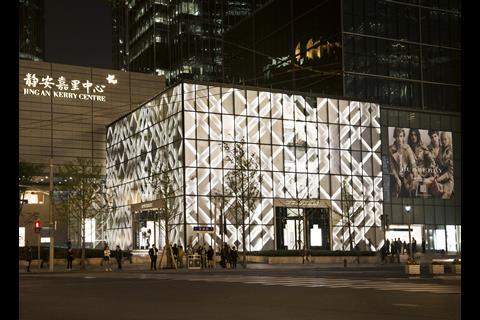
Burberry Cuts 1,700 Jobs as Luxury Giant Posts First Loss in a Decade
Burberry's Bold Gambit: 1,700 Jobs Cut in Watershed Restructuring
In the gleaming showrooms of Burberry's flagship stores, the iconic check pattern still adorns scarves and trench coats, but behind the polished facade, the British luxury stalwart is executing its most dramatic restructuring in years.
The company announced plans yesterday to eliminate approximately 1,700 jobs globally by 2027—nearly one-fifth of its workforce—as it grapples with its first operating loss in a decade and attempts to revitalize a brand that has lost its luster.
The sweeping cuts reveal the depth of Burberry's troubles and mark a critical juncture for CEO Joshua Schulman, who joined the company in July 2024 from Coach and Jimmy Choo with a mandate to turn around the struggling fashion house.

"While we are operating against a difficult macroeconomic backdrop and are still in the early stages of our turnaround, I am more optimistic than ever that Burberry's best days are ahead," Schulman stated as the company unveiled the restructuring alongside sobering financial results.
From Profit to Loss: A Fashion Icon's Fall
The numbers tell a stark story of decline. Burberry reported an operating loss of £3 million for the fiscal year ending March 29, 2025, a dramatic reversal from the £418 million profit posted just one year earlier.
Burberry's Operating Performance Decline FY2024-FY2025, Showing Transition from Profit to Loss
| Period | Operating Profit/Loss | Revenue | Operating Margin | YoY Change |
|---|---|---|---|---|
| FY2024 (Full Year) | £418 million profit | £2.97 billion | 14.1% | -36% |
| FY2025 H1 (26 weeks to Sept 28, 2024) | £53 million loss | £1.08 billion | -4.9% | -124% |
| FY2025 Q3 (13 weeks to Dec 28, 2024) | Not specified | £659 million | Not specified | -7% reported rate |
| FY2025 Forecast (Full Year) | £50.21 million pre-tax loss (est.) | £2.45 billion (est.) | Negative | Transition to loss |
Revenue plummeted 17% to £4.26 billion, while adjusted operating profit collapsed by an astonishing 94% to a mere £26 million.
These figures represent more than a temporary setback—they reflect a fundamental crisis for a brand that once stood confidently alongside luxury titans. Burberry's share price has plunged more than 75% from its April 2023 peak, a steeper decline than troubled sector peers like Kering (down 50%) and Hugo Boss (down 42%).
Luxury Fashion Stock Performance Comparison - Burberry vs Peers (April 2023 to May 2025)
| Company | 12-Month Change | YTD 2025 | Change from 52-Week Low | 52-Week Range |
|---|---|---|---|---|
| Burberry (BRBY.L) | -30.43% | -30.0% | +48.81% | £5.56-£12.55 |
| Kering (KER.PA) | -46.48% | -30.0% | +9.65% | Not specified |
| Hugo Boss (BOSS.DE) | -15.70% | Not specified | Not specified | Not specified |
| Luxury Sector Average | -21.4% | Mixed | Not applicable | Not applicable |
The company's comparable store sales declined 12% for the full year, though there were faint glimmers of hope in the second half, when sales fell by a less catastrophic 5% compared to the 20% drop in the first half.
"Burberry's performance indicates a company that has lost its way at precisely the wrong moment in the luxury cycle," noted a veteran luxury sector analyst who requested anonymity. "When the entire category is facing headwinds, you need a clear identity and exceptional execution—Burberry has struggled with both."
Summary Table of the Luxury Cycle: Stages, Characteristics, and Examples
| Stage | Key Characteristics | Examples |
|---|---|---|
| 1. Creation | Innovation, high craftsmanship, exclusivity, niche appeal | Handcrafted haute couture by emerging designer |
| 2. Aspiration | Gaining recognition, endorsed by elites, limited availability | Celebrities or influencers begin showcasing the brand |
| 3. Mass Adoption | Popular among broader audiences, accessible product lines launched | Launch of perfumes, bags, or diffusion lines |
| 4. Saturation | Overexposure, loss of exclusivity, brand fatigue sets in | Logo items become widespread; knock-offs appear |
| 5. Decline | Brand loses appeal, perceived as outdated or too common | Original luxury consumers abandon the brand |
| 6. Reinvention | Brand refreshes through rebranding, new designers, or heritage revival | Gucci under Alessandro Michele, Burberry's modern relaunch |
A Brand Identity Crisis Amid Luxury's Slowdown
Burberry's troubles coincide with broader challenges in the luxury sector, which has seen growth slow to just 2% year-over-year in 2024—the weakest performance since 2016. //CHART_INSERT:{"caption":"Global luxury market annual growth rate trend (e.g., 2016-2024).", "data_search_queries":["global luxury market growth rate historical chart", "luxury sector performance statistics"]} The shift toward "quiet luxury" has dampened demand for more ostentatious displays of wealth, creating particular challenges for brands trying to redefine themselves.
Did you know? Quiet luxury, also known as stealth wealth, is a rising trend in fashion where affluence is expressed through subtle elegance rather than flashy logos. Characterized by minimalist design, exceptional materials, and discreet branding, quiet luxury appeals to those who value timeless quality and understated sophistication. Popularized by shows like Succession and brands like The Row and Loro Piana, it reflects a shift away from conspicuous consumption toward a more refined, whisper-not-shout approach to wealth.

Internal assessments acknowledge that Burberry had "moved too far from our core with disappointing results." The brand's expression had focused on modernization at the expense of heritage, introducing unfamiliar codes and signifiers that confused loyal customers while failing to attract new ones.

Product offerings skewed toward seasonal fashion with a niche aesthetic that obscured core collections, while the pricing strategy, particularly in leather goods, didn't align with the brand's historical strengths and category authority.
Regional performance has been uneven. Asia Pacific, traditionally a stronghold for luxury brands, continued to struggle with a 9% sales decline in Q4 and a 16% drop for the full year. China, which accounts for approximately 30% of Burberry's sales, remains tepid with footfall down mid-single-digits in Q4.

The Americas provided the sole bright spot, showing a 1% sales increase in the second half after falling 21% in the first half—potentially validating Schulman's strategy of refocusing on outerwear in mall-based wholesale channels.
Beyond Job Cuts: The "Burberry Forward" Turnaround Plan
The newly announced workforce reduction is part of a comprehensive cost-cutting initiative branded "Burberry Forward," launched in November 2024. The job cuts, primarily targeting head office and overlapping regional administrative positions, aim to generate an additional £60 million in savings by 2027.
This adds to a previously announced £40 million cost-savings program, bringing total planned annual savings to £100 million by FY27. One-off costs associated with these programs are expected to total approximately £80 million, with £29 million in FY25 and the remainder in FY26.
Crucially, Burberry has ring-fenced customer-facing staff—learning from missteps during its 2016 reset when service gaps damaged the brand experience.
Beyond cost-cutting, Schulman is attempting to reconnect Burberry with its heritage. New marketing campaigns featuring celebrities like Olivia Colman and Barry Keoghan aim to drive demand for core products, while the brand is refocusing on its iconic outerwear and scarf categories, which have shown relative resilience even in challenging market conditions. //PHOTO_INSERT:{"caption":"Celebrity Olivia Colman (or Barry Keoghan) featured in a recent Burberry advertising campaign, showcasing core products.", "search_queries":["Olivia Colman Burberry campaign image", "Barry Keoghan Burberry campaign photo", "Burberry celebrity endorsement"]}

Visual merchandising in stores has been enhanced with additional mannequins and improved product displays that emphasize heritage storytelling rather than fashion-forward experimentation.
"The restructuring buys time, but it doesn't by itself buy relevance," observed a luxury retail investor. "To truly recover, Burberry must prove that Schulman's 'heritage-core' strategy can deliver mid-teens EBIT margins before the luxury cycle turns up again."
Did you know? EBIT margin—or Earnings Before Interest and Taxes margin—is a key measure of a retailer’s core profitability, showing how much of each dollar of revenue is left after operating costs are paid. Unlike net profit, it excludes financing and tax effects, offering a clear view of how efficiently a retail business runs. A higher EBIT margin often signals strong brand power and cost control, while a lower margin can indicate tight competition or inefficiencies.
Financial Lifelines and Market Response
Burberry has suspended dividend payments, preserving approximately £150 million in cash annually—a prudent move given the £100 million annualized savings target and roughly £300 million in lease obligations due in 2026.
With £0.4 billion in net cash, the company has roughly two years of runway even if free cash flow turns mildly negative, providing Schulman with breathing room to execute his turnaround strategy.
Market reaction to the job cuts has been muted, with the stock bouncing less than 3% on the news, suggesting investors had already priced in restructuring risk despite the headline severity of the announcements.
Consensus target prices imply a multiple of just 9 times FY27 expected earnings—showing no premium for Burberry's luxury intellectual property and suggesting significant upside potential if margin improvements materialize.
The Road Ahead: Scenarios and Strategic Options
Industry observers outline several potential paths forward for Burberry.
In the base case scenario, which many assign a 55% probability, sales remain flat in FY26 while EBIT margin gradually improves to 8% by FY28 as the £100 million in savings flow through. This would suggest a fair value of approximately 1,050p per share, representing modest upside from current levels.
A more optimistic view sees China rebounding in the second half of 2025 and the trench coat franchise regaining its price premium, enabling a 12% margin by FY27. This bull case, estimated at 25% probability, could drive shares toward 1,500p, near their 2019 highs.
The bear case, which some give a 20% probability, envisions a deepening luxury slowdown with price-sensitive aspirational buyers trading down and cost-cuts negatively impacting service quality. This scenario could push the share price below 800p and potentially trigger activist pressure to sell the brand to a conglomerate like Richemont or VF Corp.
Did you know? Activist investors are increasingly targeting luxury conglomerates like Richemont, LVMH, and Kering, seeing untapped value in their prestigious but complex brand portfolios. These investors push for changes like improved governance, asset restructuring, or cost-cutting to boost shareholder returns. While this pressure can enhance efficiency and transparency, it also risks clashing with the long-term, brand-building focus that defines the luxury industry.
Despite speculation about Burberry becoming an acquisition target, some contrarian analysts believe the company might actually emerge as an acquirer within three years. A minority stake in British knitwear maker Johnstons of Elgin could secure vertical cashmere supply at attractive crisis-level valuations.
Did you know? Vertical integration in the fashion industry refers to brands controlling multiple stages of their supply chain—from raw material sourcing to design, manufacturing, distribution, and retail. Luxury houses like Chanel and Hermès embrace vertical integration to ensure quality, exclusivity, and speed-to-market, while reducing reliance on third-party suppliers. This strategy enhances brand control, protects proprietary techniques, and can improve margins—but it also requires significant investment and operational expertise.
Other strategic moves could include tech collaborations, such as a potential "digital trench" partnership with Apple Vision Pro by Spring/Summer 2027, or shifting runway shows to Seoul or Singapore to hedge against geopolitical risks in China.
The Final Analysis: An Out-of-Favor Option on Recovery
For professional investors, Burberry represents an out-of-favor option on a cyclical luxury rebound with self-help upside. The stock carries relatively low risk of permanent capital loss thanks to its net-cash cushion and iconic intellectual property.
The next crucial data point will be Holiday-2025 Asia-Pacific comparable sales. If Schulman can demonstrate pricing power in this vital region, Burberry's fortunes could finally turn—transforming this rain-soaked British stalwart from fashionable outcast to investment darling once more.
As one portfolio manager put it: "Luxury brands rarely die—they hibernate. The question for Burberry is whether this restructuring represents hibernation or the beginning of a genuine renaissance."
For a company built on protecting others from the elements, Burberry now faces its own perfect storm—and its survival depends on finding shelter in its heritage while charting a course toward renewed relevance.
